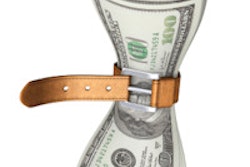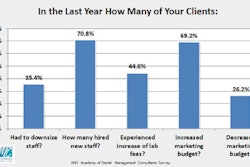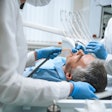
Not surprisingly, U.S. dentists' net incomes have declined in recent years, due in large part to ongoing repercussions from the economic recession.
What is surprising, however, is that the decline began in 2005, more than two years before the recession started, according to an analysis of ADA data from 1996-2009 (Journal of the American Dental Association, May 2012, Vol. 143:5, pp. 452-460).
Real net income of independent general practitioners (GPs) grew from $170,834 in 1996 to $217,850 in 2005, researchers from the ADA's Health Policy Resources Center (HPRC) found. But in 2006 the trend began to reverse, and by 2009 (the most recent year for which the data were available) their real net income had dropped to $192,680 -- roughly the same level as in 1998.
“The consequences could be far reaching.”
— ADA Health Policy Resources Center
"If the decrease is primarily cyclical, then net income levels should be expected to recover as the economy recovers," the study authors wrote. "If the change is primarily for the long term, however, the consequences could be far reaching."
There have been slight decreases in average real net income for short periods historically owing to economic downturns, but the decrease that began after 2005 is the longest one seen during the entire period from 1981 through 2009, they added.
Multiple underlying factors
The researchers examined results from the ADA's annual Survey of Dental Practice, which is conducted with a national random sample of 4,000-7,000 dentists in private practice, and data from the Agency for Healthcare Research and Quality's Medical Expenditure Panel Survey.
They considered several potential factors that could account for the decline in net income, which was defined as gross billings minus total practice expenses:
- Average real gross billings per visit could have decreased.
- Average rate of collection of gross billings could have decreased.
- Average number of annual visits to a dentist among people who visited a dentist could have decreased.
- The percentage of the population who visited a dentist in the preceding year could have decreased.
- The population to dentist ratio could have decreased.
- Average real practice expenses per dentist could have increased.
With regard to gross billings, they found that from 2007 to 2009, average real net income continued to decrease in spite of an increase in real gross billings. In addition, the average number of visits per patient decreased from two per year in 2005 to 1.9 per year in 2009 -- although this trend actually began in 2002.
When the researchers summarized these trends -- as well as an increase in practice expenses and a decrease in overall dental visits -- across time, they found that the decrease in dentists' net income levels was driven primarily by a decrease in utilization of dental care, and that this decline began before the economic downturn.
"This factor alone suggests that GPs' average real net income may not necessarily recover to its prerecession level once economic conditions in the United States improve," the study authors wrote.
Combined with the potential implications of health care reform for dentistry, they added, "the future prospects related to GPs' net income levels remain uncertain."
In addition, if GPs' net income levels continue to decline, it is likely that older dentists will delay retirement and remain in the workforce longer, they speculated. A continued decline in net income levels is also likely to reduce the number of applicants to dental school.
"We have seen historically quite a close link between future earnings compared to education costs and the number of dental school applicants," lead author Marko Vujicic, PhD, managing vice president of the HPRC, told DrBicuspid.com. "So as incomes fall, we would expect to see a slight downturn in applicants."
Even so, while it is a time of "incredible uncertainty" for dentistry, "with that comes opportunity," Vujicic added.
A more optimistic view
David Goodman, CPA, of the Academy of Dental Certified Public Accountants, sees a brighter future ahead for U.S. dentistry than the ADA study suggests. He contends that the analysis -- while well done -- missed some key trends.
"This report doesn't stray far from the reality of the numbers," he said. "But when you go outside of the numbers, there are some things they may have overlooked that would paint a much brighter picture of the future of dentistry."
For example, declining enrollment in dental schools could ultimately mean fewer dentists competing in the marketplace, Goodman noted. In addition, he sees more GPs doing procedures -- specifically in orthodontics and endodontics -- that traditionally were referred to specialists, thereby creating new revenue streams.
And contrary to the study's findings about increases in the cost of running a dental practice, the recession has prompted dentists to become more cost-conscious, he added -- a practice he doesn't see changing any time soon.
"When the economy started to turn downwards, initially a lot of doctors said 'okay, I'll try and hold on as best I can,'" Goodman said. "But when things didn't get better quick enough, we saw a lot of our dentists start to focus on overhead and become more conscious of their spending. And as the economy started to improve, because they had been running leaner in terms of expenses, their income began improving faster than their revenue was improving."
In addition, he believes that by not incorporating data beyond 2009, the findings are more negative than they might have been.
"The study uses a formula based on information gathered from various sources, including those that track the overhead expenses of dental practices, to show that net income was going down," Goodman said. "But I think 2009 was too early to make that interpretation. I think that when they incorporate 2010 data, they are going to find a better trend."
In addition, pending healthcare reforms should create new opportunities for dentists going forward, he added.
"I think that what will happen with the reforms is that those people who could not afford or have access to dental care before will now have access to that care," he said. "And once you have access to a dentist and understand what they can offer, you will continue to go to the dentist."
The ADA's HPRC is currently studying the potential impact of healthcare reform on dentistry and will be providing an update on this research to the House of Delegates this fall, according to Vujicic.



















